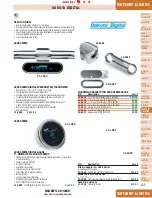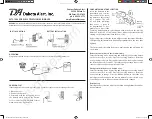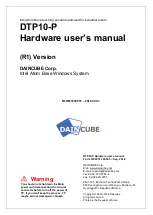
D600-51-00
Pittway Tecnologica S.r.l, Via Caboto 19/3, 34147 Trieste, Italy
© System Sensor 2007 I56-2643-005
1
0
8
7
1
2
3
4
5
6
9
0
8
7
1
2
3
4
5
6
9
10
12
13
14
15
TENS
ONES
0832
0832-CPD-0519
INSTALLATION AND MAINTENANCE INSTRUCTIONS FOR MODEL 2251TLE
ANALOGUE ADDRESSABLE MULTI-CRITERIA SMOKE SENSOR
Before installing the sensor, please thoroughly read System Sensor's "Guide to Intelligent Fire Systems", which includes detailed information on
sensor spacing, placement, zoning and special applications. Copies of this guide are available at no charge from System Sensor.
GENERAL DESCRIPTION
Model 2251TLE analogue addressable sensors are microprocessor controlled plug-in type smoke sensors that use software algorithms to
combine Photo electric, thermal and infra-red sensing elements with addressable-analogue communications giving reliable fire detection whilst
allowing the detector to reject many common causes of nuisance alarm. These sensors are designed for open area protection and must only be
connected to control panels that use a compatible proprietary analogue addressable communication protocol for monitoring and control.
Two LEDs on each sensor light to provide a local 360° visible sensor indication. The LEDs can be latched on by code command from the control
panel for an alarm indication. They can also be unlatched to the normal condition by code command. Remote LED indicator capability is
available as an optional accessory wired to the standard base terminals.
SPECIFICATIONS
Operating Voltage Range:
15 to 32 VDC
Max. Standby Current:
200 µA @ 24 VDC (no communication)
Max. Avg. Standby Current:
300 µA (one communication every 5 sec. with LED blink enabled)
Max. Alarm Current (LED on):
7 mA @ 24 VDC
Operating Humidity Range:
15% to 90% Relative Humidity, non-condensing
Temperature Range:
-30°C to 60°C
Nominal Activation Temperature:
60°C
Compatible Detector Bases:
B501, B501DG, B524IEFT-1, B524HTR, B524RTE.
Height:
68 mm installed in B501 Base
Diameter:
102 mm installed in B501 Base
Weight:
124 g
The 2251TLE meets the requirements of EN54-7 , CEA 4021 and EN54-5.
WIRING GUIDE
Refer to the relevant detector base installation instructions for wiring details. All bases are provided with terminals for power and an optional
Remote Indicator.
NOTE: All wiring must conform to applicable local and national codes and regulations.
NOTE: Verify that all sensor bases are correctly installed and that polarity of the wiring is correct at each base.
WARNING
Disconnect loop power before installing sensors
SENSOR INSTALLATION
1.
Set the sensor address (see Figure 1) by using a flat blade screwdriver to turn the two rotary switches, selecting the desired number
between 01 and 159. Note: Some control panels are only able to use 99 addresses. Check with the fire panel manufacturer to clarify this.
Record the address on the label attached to the base.
2.
Insert the sensor into the base and rotate it clockwise with gentle pressure until it drops into place.
3.
Continue to rotate the sensor until it locks into the base.
4.
After all the sensors have been installed, apply power to the system.
5.
Test the sensor as described under TESTING.
6
Reset the sensor by communication command from the panel.
Tamper Resistance
All system sensor plug in bases include a feature that, when activated, prevents removal of the sensor without the use of a tool. Refer to the
installation instructions for the sensor base for details of how to use this feature.
CAUTION
Dust covers help to protect units during shipping and when first installed. They are not intended to provide complete protection
against contamination therefore sensors should be removed before construction, major re-decoration or other dust producing work
is started. Dust covers must be removed before system can be made operational.
Figure 1: Rotary Decade address Switch
In addition, check to ensure that the LEDs blink (if this feature is operational under software
command). If they do not, power has been lost to the sensor (check the wiring).
Test the sensors as follows:
Magnet Test
1.
Test the sensor by positioning the test magnet (Model M02-04, optional) against the
sensor body approximately 2cm from the LED as indicated in Figure 2.
2.
Both LEDs should latch on within 30 seconds indicating an alarm and activating the
panel.
Smoke Test
1.
At alarm levels 4 and 5, the 2251TLE includes electronic delays of upto 3 minutes for a
smoke only response. To disable the delay for ten minutes, a magnet test as
described above should be carried out prior to the smoke tests.
2.
Use either a canned smoke aerosol or a detector tester for generating artificial smoke
to test the detector. Inject the smoke into the detector's chamber using the test smoke
as recommended by the manufacturer and ensure that it is present until an alarm
occurs on the detector.
3.
The red alarm LED should latch on within 30 seconds indicating an alarm and
activating the panel into a condition to indicate the detector under test.
Direct Heat Method (Hair dryer of 1000-1500 watts).
1.
Direct the heat toward the sensor from its side. Hold the heat source about 15 cm
away to prevent damage to the cover during testing.
2.
The LEDs on the sensor should light when the temperature at the detector reaches
60°C. If the LEDs fail to light, check the power to the sensor and the wiring in the
sensor base.
Following any of the above tests, the sensor should be reset at the system control panel. If
the sensor fails these tests, they should be returned for repair.
MAINTENANCE
Before cleaning, notify the proper authorities that the system is undergoing maintenance and
will be temporarily out of service. Disable the system to prevent unwanted alarms.
1.
Remove the sensor to be cleaned from the system.
2.
Remove the sensor cover. Use a small flat blade screwdriver to gently release each
of the four cover removal tabs that hold the cover place. Use caution to avoid
damaging the thermistors and other sensors
3.
Carefully vacuum the outside of the anti insect screen without removing it from the
detector cover.
4.
The chamber cover and IR sensors may be removed as a single assembly. Gently
pull the assembly away from the sensing chamber being careful neither to damage the
thermistors, the IR sensor PCB nor to strain the connector cable to the PCB, then
gently folded away from the optical chamber.
5.
Use a vacuum cleaner and/or clean compressed air to remove dust and debris from
the sensing chamber and sensing chamber cover.
6.
Re-install the sensing chamber cover assembly by sliding the cover over the
chamber, gently pressing it home until it snaps into place.
8.
Re-install the sensor cover. Use the cover removal tabs, LEDs and thermistors to
align the cover with the sensor. Snap the cover into place.
10.
When all sensors have been cleaned and re-installed, restore power to the loop and
test the sensor(s) as described under TESTING.
After completion of maintenance and testing, notify the proper authorities that the system is
operational.
TEST
MAGNET
Figure 3: Sensor with Cover Removed
SENSOR COVER
COVER
REMOVAL
TABS
IR SENSOR
WARNING - LIMITATIONS OF SMOKE DETECTORS
The 2251TLE Multi Criteria detector is designed to activate and initiate emergency action, but will do so only when used in conjunction with other
equipment. Fire detectors will not work without power.
The 2251TLE will not sense fires when the smoke, heat, or IR light does not reach the sensors. Stimuli from fires in chimneys, in walls,
on roofs, or on the other side of closed doors may not reach the detector and trigger the unit.
A detector may not detect a fire developing on another level of a building. Hence, detectors should be located on every level for a building.
Fire detectors also have sensing limitations. In general, detectors cannot be expected to provide warnings for fires resulting from inadequate
fire protection practices, violent explosions, escaping gas, improper storage of flammable liquids like cleaning solvents, other safety hazards, or
arson. Fire detectors used in high air velocity conditions may fail to alarm due to dilution of smoke densities created by such frequent and rapid
air exchanges. Additionally, high air velocity environments may create increased dust contamination, demanding more frequent maintenance.
Fire detectors contain electronic parts, and cannot last forever. The 2251TLE electronic components may be expected to last 10 years,
however any of the components could fail at any time. Your fire detection system should therefore be tested at least semi-annually. Clean and take
care of your fire detectors regularly. Taking care of the fire detection system you have installed will significantly reduce your product liability risks.
OPTICAL
CHAMBER
COVER
TESTING
Sensors must be tested after installation and following periodic maintenance. However, before testing, notify the proper authorities that the smoke
detector system is undergoing maintenance and the system will be temporarily out of service. Disable the zone or system undergoing
maintenance to prevent unwanted alarms.
Figure 2: Test Magnet Positioning
OPTICAL
CHAMBER BASE
THERMISTORS
DETECTOR BASE






















